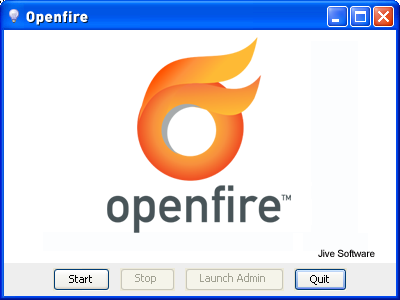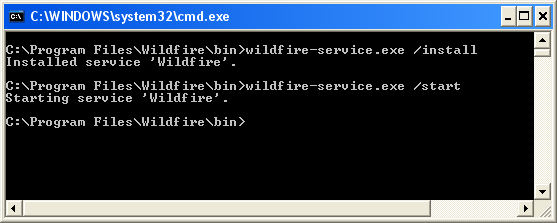Installation Guide
Openfire is a powerful instant messaging (IM) and chat server that implements the XMPP protocol. This document will guide you through installing Openfire. For a full list of features and more information, please visit the Openfire website: http://www.igniterealtime.org/projects/openfire/
Installation
Windows
Run the Openfire installer. The application will be installed to c:\Program Files\Openfire by default.Linux/Unix
Choose either the RPM or tar.gz build. If using the RPM, run it using your package manager to install Openfire to /opt/openfire:rpm -ivh openfire_3_0_0.rpm
If using the .tar.gz, extract the archive to /opt or /usr/bin:tar -xzvf openfire_3_0_0.tar.gz
mv openfire /opt
Note: the .tar.gz build does not contain a bundled Java runtime (JRE). Therefore, you must have JDK or JRE 1.5.0 (Java 5) or later installed on your system. You can check your java version by typing "java -version" at the command line and (if necessary) upgrade your Java installation by visiting http://java.sun.com.
Setup Overview
To complete the installation of Openfire, you'll need to perform each of the following steps:
- Database - if you choose to use an external database, you must prepare your database for Openfire.
- Setup - Use the built-in web-based setup tool to setup and verify the server configuration.
- Admin Console - use the web-based admin tool to manage the server.
This document also includes information on:
Files in the Distribution
The files in your distribution should be as follows (some sub-directories omitted for brevity):
openfire/
|- readme.html
|- license.html
|- conf/
|- bin/
|- jre/
|- lib/
|- plugins/
|- admin/
|- resources/
|-database/
|-security/
|- documentation/
- The conf directory is where Openfire stores configuration files.
- The bin directory contains the server executables. Depending on which distribution you installed, different executables will be available.
- The jre directory contains a Java 5 runtime that is bundled with the Windows and RPM versions of Openfire.
- The lib directory contains libraries necessary for running Openfire.
- The plugins directory contains server plugins. By default, Openfire ships with a web-based admin console plugin.
- The resources/database directory contains SQL schema files to create new Openfire databases, as well as upgrade scripts for existing installations.
- The resources/security directory is where Openfire maintains keystores to support SSL connection security.
- The documentation directory contains server documentation.
Setup the Database
Openfire can store its data in an embedded database or you can choose to use an external database such as MySQL or Oracle. If you would like to use an external database, you must prepare it before proceeding with installation. View the database setup documentation for more information.
Setup the Server
A web-based, "wizard" driven setup and configuration tool is built into Openfire. Simply launch Openfire (platform-specific instructions below) and use a web browser to connect to the admin console. The default port for the web-based admin console is 9090. If you are on the same machine as Openfire, the following URL will usually work: http://127.0.0.1:9090. Initial setup and administration can also be done from a remote computer using LAN IP address instead or hostname if it is resolvable by the remote computer. Windows Server administrators should add http://127.0.0.1 address to Internet Explorer's Trusted Sites list, if Enhanced Security configuration is enabled in Internet Explorer. Otherwise they will get a blank screen.
Admin Console
After completing the above steps, Openfire will be configured
and you can use the web-based admin console to administer
the server. The URL should be the same as you used to setup the server
unless you changed the port during the setup.
Running Openfire in Windows
If you used the Openfire installer, a shortcut for starting the a graphical launcher is provided in your Start Menu. Otherwise, run openfire.exe in the bin/ directory of your Openfire installation. A button on the on the launcher allows you to automatically open your web browser to the correct URL to finish setting up the server:

Windows Service
If you're running Openfire on Windows, you will likely want to run Openfire as a standard Windows service after initial setup. If you used the Windows installer, a openfire-service.exe file will be in the bin directory of the installation. You can use this executable to install and control the Openfire service.
From a console window, you can run the following commands:- openfire-service /install -- installs the service.
- openfire-service /uninstall -- uninstalls the service.
- openfire-service /start -- starts the service
- openfire-service /stop -- stops the service.

You can also use the Services tool in the Windows Control Panel to start and stop the service.
Note: the graphical launcher is not compatible with the Windows service at this time. If you install the service, you should use service controls as described above to control the server rather than the graphical launcher.
Custom Parameters
Advanced users may wish to pass in parameters to the Java virtual machine (VM) to customize the runtime environment of Openfire. You can do this by creating vmoptions files in the bin/ directory of your Openfire installation. For the Windows service, you'd create a new text file called openfire-service.vmoptions. Each parameter to the VM should be on a new line of the file. For example, to set the minimum heap size to 512 MB and max VM heap size to 1024 MB, you'd use:
-Xms512m -Xmx1024mTo create parameters for the normal launcher, create a file called openfired.vmoptions (since the openfire.exe launcher invokes the openfired.exe executable to actually start the server).
Running Openfire in Linux/Unix
If you are running on a Red Hat or Red Hat like system (CentOS, Fedora, etc), we recommend using the RPM as it contains some custom handling of the standard Red Hat like environment. Assuming that you have used the RPM, you can start and stop Openfire using the /etc/init.d/openfire script.
# /etc/init.d/openfire
Usage /etc/init.d/openfire {start|stop|restart|status|condrestart|reload}
# /etc/init.d/openfire start
Starting openfire:
# ./openfire
Usage: ./openfire {start|stop}
# ./openfire start
Starting openfire
- redhat-postinstall.sh -- automatically installs Openfire as a service on Red Hat. It does so by creating a "jive" user and then copying the openfired script to your init.d directory. This script must be run as root. Please see the comments in the script for additional information.
- openfired -- script to run Openfire as a service. You must manually configure this script. See the comments in the script for additional details.
Custom Parameters
Advanced users may wish to pass in parameters to the Java virtual machine (VM) to customize the runtime environment of Openfire. If you installed via RPM, you can customize this by editing /etc/sysconfig/openfire and looking at the OPENFIRE_OPTS option. If you installed via .tar.gz, you will need to tweak your startup script to fit your needs.